The Controversy Surrounding Stablecoins and Tether’s USDT
Deutsche Bank Research recently stirred up a heated discussion in the financial industry by examining stablecoins and their risks, particularly focusing on Tether’s USDT. The analysis, based on a review of 334 currency pegs dating back to 1800, revealed that only 14% of them have managed to maintain stability over time. This finding raises concerns about the sustainability of stablecoins like USDT, which aim to retain a fixed value relative to fiat currencies such as the US dollar.
Tether’s Reaction to the Deutsche Bank Report
Stablecoins, most notably USDT, play a vital role in the cryptocurrency market by providing traders with a reliable asset in the face of the sector’s inherent volatility. With USDT’s market capitalization exceeding $100 billion, it often surpasses Bitcoin in daily trading volumes.
- The stability and transparency of Tether’s practices have been called into question by Deutsche Bank’s recent report, which refers to past regulatory issues that have cast doubt on the company’s trustworthiness.
- In 2021, Tether faced hefty fines from regulatory bodies, including a $41 million penalty from the Commodity Futures Trading Commission and an $18.5 million settlement with the New York Attorney General, both stemming from misleading claims regarding its reserve holdings.
Concerns Over Stability and Compliance
Deutsche Bank’s analysts highlight the historical success of pegged currencies that were backed by robust reserves, enjoyed high credibility, and were subject to strict regulation. In contrast, many leading stablecoins like USDT lack these key attributes, raising doubts about their long-term stability:
- The collapse of Terraform Labs’ TerraUSD and Luna, which led to a $40 billion loss in the crypto market, exemplifies the potential risks associated with unstable stablecoins.
- Tether’s dominant position in a market marked by speculation and opacity, coupled with its uncertain compliance record, could pose broader risks to the cryptocurrency ecosystem.
JPMorgan’s Concerns Over USDT’s Dominance
In a similar vein, JPMorgan recently expressed apprehensions about the growing dominance of Tether’s USDT in the stablecoin market, with USDT commanding over 69% market share according to DefiLlama:
- These challenges have not deterred Tether’s CEO, Paolo Ardoino, who remains upbeat about the company’s prospects despite the criticisms and regulatory scrutiny.
- Regulatory changes in the US, contemplating stablecoin regulations, and the European Union’s planned implementation of the Markets in Crypto-Assets Regulation (MiCA) could significantly impact the compliance and operational standards for stablecoin issuers like Tether.
The Future of Stablecoins in a Regulated Landscape
As the debate around stablecoins and Tether’s USDT intensifies, regulatory scrutiny and market dynamics will play a crucial role in shaping the future of this rapidly evolving sector. The decisions made by global regulators and the actions taken by stablecoin issuers will determine the credibility and stability of these digital assets in the years to come.

